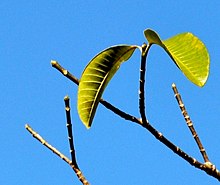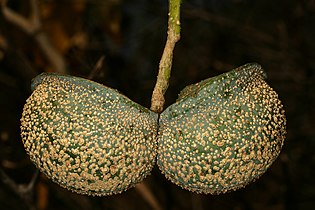| Toad tree | |
|---|---|

| |

| |
| Habit and the opposite, entire leaves in Limpopo, South Africa | |
| Scientific classification | |
| Kingdom: | Plantae |
| Clade: | Tracheophytes |
| Clade: | Angiosperms |
| Clade: | Eudicots |
| Clade: | Asterids |
| Order: | Gentianales |
| Family: | Apocynaceae |
| Genus: | Tabernaemontana |
| Species: | T. elegans
|
| Binomial name | |
| Tabernaemontana elegans | |
| Synonyms[2] | |
| |
Tabernaemontana elegans, the toad tree,[3] is a shrub or small tree in the family Apocynaceae. It is native to eastern Africa.
Description[edit]
Tabernaemontana elegans grows up to 15 metres (50 ft) tall, with a trunk diameter of up to 30 centimetres (12 in). Its fragrant flowers feature white, creamy or pale yellow corolla lobes. Fruit consists of 2 separate ovoid or ellipsoid pods, up to 8 centimetres (3 in) each.
Distribution and habitat[edit]
Tabernaemontana elegans grows in forests or bushland from sea level to 1,000 metres (3,300 ft) altitude. The species is native to Somalia, Kenya, Tanzania, Mozambique, Zimbabwe, Eswatini and South Africa.[4][5][6]
Uses[edit]
Tabernaemontana elegans has some local medicinal uses including the treatment of heart disease, cancer, tuberculosis and venereal diseases. The species is also used as an aphrodisiac.[4] The Zulu name for this genus, iNomfi, refers to the use of their sticky, milky latex as bird-lime.[7]
Chemistry[edit]
Fourteen indole alkaloids have been isolated in the callus culture of Tabernaemontana elegans (isovoacangine, 3-R/S-hydroxy-isovoacangine, 3-R/S-hydroxy-coronaridine, isositsirikine, geissoschizol, tabernaemontanine, vobasine, vobasinol, apparicine, 16-hydroxy-16,22-dihydro-apparicine, tubotaiwine, 3-R/S-hydroxy-conodurine and monogagaine) of which apparicine is the principal.[8]
-
Milky latex
-
Inflorescence
-
Flower
-
Warty, symmetrical fruit
-
Visible seeds in dehisced fruit
References[edit]
- ^ Botanic Gardens Conservation International (BGCI).; IUCN SSC Global Tree Specialist Group (2019). "Tabernaemontana elegans". IUCN Red List of Threatened Species. 2019: e.T149502995A149502997. doi:10.2305/IUCN.UK.2019-2.RLTS.T149502995A149502997.en. Retrieved 20 November 2021.
- ^ a b "Tabernaemontana elegans". World Checklist of Selected Plant Families (WCSP). Royal Botanic Gardens, Kew. Retrieved 20 January 2020.
- ^ "Tabernaemontana elegans". Germplasm Resources Information Network. Agricultural Research Service, United States Department of Agriculture. Retrieved 20 January 2020.
- ^ a b Medicinal Plants. PROTA. 2008. pp. 592–593. ISBN 978-9-05782-204-9.
- ^ "Tabernaemontana elegans". Flora of Zimbabwe. Retrieved 4 August 2013.
- ^ "Tabernaemontana elegans". Encyclopedia of Life. Retrieved 4 August 2013.
- ^ Palmer, Eve (1977). A Field Guide to the Trees of Southern Africa. London, Johannesburg: Collins. pp. 303–304. ISBN 0-620-05468-9.
- ^ Indole alkaloids from a callus culture of Tabernaemontana elegans. R. van der Heijden, R.L. Brouwer, R. Verpoorte, R. Wijnsma, T.A. van Beek, A.A. Harkes and A. Baerheim Svendsen, Phytochemistry, Volume 25, Issue 4, doi:10.1016/0031-9422(86)80013-9





